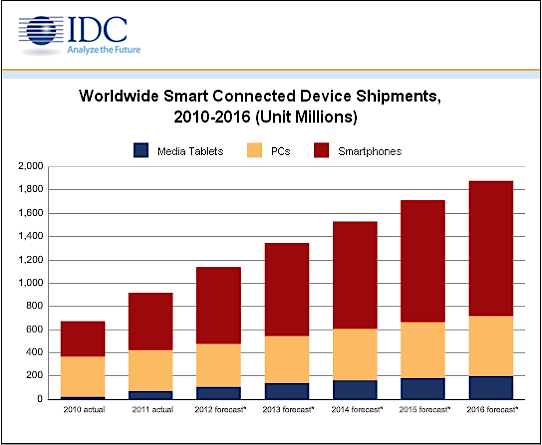The Cloud, Big Data and connected devices lift Intel semiconductors sales
 For all the talk about the post-PC era and rise of alternate chip architectures, Intel defies gravity's pull. The microprocessing giant's dominance grows stronger, not lesser, which is strange juxtaposition to analyst predictions about media tablets and smartphones running ARM processors ending the PC's decades-long supremacy.
For all the talk about the post-PC era and rise of alternate chip architectures, Intel defies gravity's pull. The microprocessing giant's dominance grows stronger, not lesser, which is strange juxtaposition to analyst predictions about media tablets and smartphones running ARM processors ending the PC's decades-long supremacy.
This week, iSuppli reports that Intel's share of the semiconductor market reached its highest level in a decade, 15.6 percent, largely based on its core chip business. "Intel in 2011 saw its revenue jump by 20.6 percent", Dale Ford, head of iSuppli Electronics and Semiconductor Research, says. "This outpaced every other semiconductor supplier in the Top 20 with the exception of Qualcomm Inc. and ON Semiconductor, both of which also saw exceptionally high levels of growth based on a combination of organic expansion and key acquisitions".
Ford adds: "Until 2011, Samsung had been steadily closing the gap with Intel, with its share of global semiconductor market revenue rising from 3.9 percent in 2000 to 9.2 percent in 2010", Ford says. "Samsung’s revenue growth of 0.6 percent in 2011 left its overall market share unchanged at 9.2 percent in 2011". Texas and Toshiba ranked third and fourth.
Other measures show Intel's dominance in its traditionally core market -- x86 processors. During fourth quarter, the broader market for PC and server microprocessors generated $10.9 billion in sales, up 14.2 percent year over year, according to IDC. Intel's overall market share was 80.3 percent, but much higher for servers: 94.5 percent.
Looking ahead, Gartner predicts a surge in semiconductor spending during second half of 2012, reaching $316 billion for the year, a 4 percent increase. Product highlights:
- Media tablet production will increase 78 percent year over year to $9.5 billion. Gartner expects quad-core processors and high-resolution displays to be mainstream this year.
- PC unit production will increase by 4.7 percent, generating $57.8 billion in revenue.
- Mobile phone production will increase by 6.7 percent, to $57.2 billion.
"2012 should be a reasonably strong year for the semiconductor industry if the macroeconomic outlook stays in check", Bryan Lewis, Gartner research vice president, says. "Growth projections assume the European debt issues stay contained, Iran/Israel tensions stay in check, and solid growth from China".
Planets Align
Intel benefits from a convergence of events -- the planets lining up, so the speak, much as they will for Mayan 2012 end-of-the-world predictions. These are particularly true for businesses. I've identified eight trends, many of which benefit Intel's recently announced Xeon processor E5-2600 product family. They are:
1. Economic recovery. While the post-2008 economic collapse initially forced cutbacks in IT spending, the recovery, however modest, unleashed pent up demand for enterprise infrastructure upgrades last year. But the Euro crisis has put the kibosh on some spending. Two months ago, Gartner lowered IT spending projections for 2012 -- to $3.8 trillion, with growth expected to be 3.7 percent year over year instead of 4.6 percent.
Other forecasters are more optimistic. Forrester predicts that IT spending will rise by 5.4 percent in 2012.
2. Changing role of IT. Ongoing economic crises have helped foster unexpected change, leading more businesses to look to CIOs and their staffs to generate revenue rather rather than just slash budgets.
"There has been a whole transformation that IT has played over the years", Ajay Chandramouly, Intel IT Cloud Computing and Datacenter Industry Engagement manager, says. "If you go back to 2008, perhaps earlier, IT was viewed as a cost center. It was all about doing more with less. Since then, with things like Big Data, cloud and consumerization, things have changed for IT. We now have a seat at the table, with business groups making product decisions that impact the top line".
![]()
3. Windows. When Microsoft launched Windows 7 in autumn 2009, XP accounted for 85 percent of the install base. Many businesses spent the following two years upgrading to the newest desktop operating system. During Microsoft's fiscal 2012 second quarter, Windows division revenue decline 6 percent and profit by 11 percent -- but that was mostly from a fall-off in consumer spending. Many businesses continued deploy Windows 7 on new PCs, which benefitted Intel microprocessor sales. Windows 8 is coming, along with a slew of supporting server software.
4. Consumerization of IT. Smartphones and tablets are now an undeniable reality among businesses. For example, Forrester finds that 27 percent companies support iPads today with another 31 percent planning to. Meanwhile, many businesses build out private, public or hybrid clouds to support these devices (see #7).
5. Virtualization. Businesses see many benefits for desktop and server virtualization. On the desktop, connecting to disparate devices drives demand. On the server consolidation is leading trend (see #6).
"As organizations begin to support connected smart devices such as iPads and smartphones, they also want to connect them to their enterprise data and applications", Forrester analyst Clarence Villanueva says. "Companies are turning to desktop virtualization as a solution to make that happen"
6. Server consolidation. Not since the three years preceding the so-called Y2K crisis has server consolidation been such a hot trend, and virtualization is driving catalyst allowing more businesses to maintain legacy operations while investing in newer tech.
Globally, server revenue rose 7.9 percent year over year in 2011 and units by 7 percent, according to Gartner. Forrester predicts server spending will reach $79 billion this year.
7. Cloud computing. The cloud has three primary faces: Public, private on-premise and hybrid between the two. The cloud is one of the major forces driving semiconductor spending today, whether devices or servers supporting them.
For example, many businesses continue to increasing spending on software as service, which will drive up revenues 17.9 percent year over year in 2012 -- to $14.5 billion, according to Gartner, which expects them to reach $22.1 billion by 2016.

One hot new server trend is infrastructure as a service, but right now "the main effects of IaaS have been to boost demand for server and storage hardware from telecommunications firms, outsourcers, Chinese regional governments, and hardware vendors themselves that want to compete with the early leaders like Amazon.com and Rackspace", Forrester analyst Andrew Bartels writes in a January report.
"Increasing familiarity with the SaaS model, continued oversight on IT budgets, the growth of platform as a service (PaaS) developer communities and interest in cloud computing are now driving adoption forward", Sharon Mertz, Gartner research director, says.
8. Big Data. You can't much of anywhere in IT without hearing this buzzword. But it's more than some analyst marketing gimmick, as more businesses see the value of information in global economy and the push to public and private clouds generate terabytes of data.
"The Big Data market is expanding rapidly as large IT companies and startups vie for customers and market share", Dan Vesset, IDC program vice president, says. "For technology buyers, opportunities exist to use Big Data technology to improve operational efficiency and to drive innovation".
IDC expects the market to reach $16.9 billion by 2015. Yesterday, the White House launched a $200 million Big Data initiative for the federal government.
"There are also Big Data opportunities for both large IT vendors and start ups", Vesset says. "Major IT vendors are offering both database solutions and configurations supporting Big Data by evolving their own products as well as by acquisition. At the same time, more than half a billion dollars in venture capital has been invested in new Big Data technology".
Big Iron
Intel had a great year for semiconductors, but the challenge ahead is change, and there is lots of it. Many of these eight trends demand more processing power on the server, which the company plans to meet with the recently announced Xeon processor E5-2600 product family.
Chandramouly describes the E5 as a "bandwidth machine". The chip features eight cores, but effectively more. "Each of these cores is multithreaded, so effectively you have up to 16 cores, or 16 threads".
Other benefits include:
- Up to 768GB of system memory
- Integrated PCI Express controller
- Improved energy efficiency (up to 50 percent)
- Increased performance (up to 80 percent over previous generation)
Intel also improved the caching technology such that "all the cores can access data simultaneously, so logically it's one cache but physically it's multiple slices", Chandramouly says. The E5 also bumps up to four-channel DDR3 memory, "which gives us a 30 percent bump in bandwidth".
Editor's note: Intel sponsored this story, which was independently conceived, reported and written. The company did provide an executive for us to interview. BetaNews' policy is full editorial control, which we maintained for this analysis.
Photo Credit: Sergey150770/Shutterstock